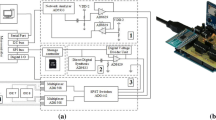Abstract
All living cells possess electrical characteristics and are thus responsive to, and even generate electric fields and currents. It has been shown that the electrical properties of cancer cells differ from normal proliferating cells, thus electric fields may induce differential effects in normal and cancer cells. Manipulation of these electrical properties may provide a powerful direct and/or adjuvant therapeutic option for cancer. A whole cell impedance-based biosensor to monitor the effects of a range of different frequencies (50 kHz–2 MHz) at low-intensity (<2 V/cm) on the growth rate of human SKOV3 ovarian cancer cells versus non-cancerous HUVECs is reported. Rapid real-time monitoring of the SKOV3 behavior was observed as the alternating electric fields were applied and the impedimetric response of the cells was recorded. The cells were also labeled with propidium iodide to examine morphological changes and cell viability with fluorescence microscopy with trypan blue for comparison. A noticeable decrease in the growth profile of the SKOV3 was observed with the application of 200 kHz alternating electric fields indicating specific inhibitory effects on dividing cells in culture in contrast to the HUVECs. The outcome of this research will improve our fundamental understanding of the behavior of cancer cells when exposed to alternating electric fields at specific frequencies and foster the development strategies and optimal parameters for alternating electric field therapies for clinical and drug delivery applications.





Similar content being viewed by others
References
A.T. Barker, R.A. Dixon, W.J.W. Sharrard, M.L. Sutcliffe, Lancet 323, 994–996 (1984)
D.J. Blackiston, K.A. McLaughlin, M. Levin, Cell Cycle 8, 3527–3536 (2009)
N.A. Charoo, Z. Rahman, M.A. Repka, S.N. Murthy, Curr. Drug Deliv. 7, 125–136 (2010)
E. Elson, in The biomedical engineering handbook, ed. by J.D. Bronzino (CRC Press, Inc, Boca Raton, 1995), pp. 1417–1423
F. Fantozzi, E. Arturoni, R. Barbucci, Bioelectrochemistry 78, 191–195 (2010)
M. Golzio, J. Teissié, M.P. Rols, PNAS 99, 1292–1297 (2002)
S. Hirohashi, Am. J. Pathol. 153, 333–339 (1998)
E. Hondroulis, C. Liu, C.Z. Li, Nanotechnology 21, 315103 (2010)
E. Hondroulis, Z. Zhang, C. Chen, C.-Z. Li, Anal. Lett. 45, 272–282 (2012)
M. Ieran, M. Bagnacani, M. Annovi, A. Moratti, R. Cadessi, J. Orthop. Res. 8, 276–282 (1990)
E.D. Kirson, V. Dbaly, F. Tovarys, J. Vymazal, J.F. Soustiel, A. Itzhaki, D. Mordechovich, S. Steinberg-Shapira, Z. Gurvich, R. Schneiderman, Y. Wasserman, M. Salzberg, B. Ryffel, D. Goldsher, E. Dekel, Y. Palti, PNAS 104, 10152–10157 (2007)
X. Lin, D. Dean, Am. J. Respir. Crit. Care Med. 183, A2099 (2011)
F.E. Lock, N. Underhill-Day, T. Dunwell, D. Matallanas, W. Cooper, L. Hesson, A. Recino, A. Ward, T. Pavlova, E. Zabarovsky, M.M. Grant, E.R. Maher, A.D. Chalmers, W. Kolch, F. Latif, Oncogene 29, 4307–4316 (2010)
J.H.T. Luong, K.B. Male, J.D. Glennon, Biotechnol. Adv. 26, 492–500 (2008)
L.M. Mir, Bioelectrochemistry 53, 1–10 (2001)
R. Sandyk, J. Altern. Complement. Med. 3, 365–386 (1997)
M. Sok, M. Sentjurc, M. Schara, J. Stare, T. Rott, Ann. Thorac. Surg. 73, 1567–1571 (2002)
L. Song, L. Chau, Y. Sakamoto, J. Nakashima, M. Koide, R. Tuan, Mol. Ther. 9, 607–616 (2004)
B. Szachowicz-Petelska, I. Dobrzynska, S. Sulkowski, Z.A. Figaszewski, J. Environ. Biol. 31, 845–850 (2010)
J. Teissié, J. Escoffre, M. Rols, M. Golzio, Radiol. Oncol. 42, 196–206 (2008)
T.Y. Tsong, Annu. Rev. Biophys. Biophys. Chem. 19, 83–106 (1990)
X. Zhao, M. Zhang, R. Yang, Commun. Nonlinear Sci. Numer. Simul. 15, 1400–1407 (2010)
Acknowledgments
This research and development project was supported by the grant NIH R15 ES021079-01, Young Inventor Award by W. H. Coulter Foundation to Cz Li, and the Research Foundation for Doctoral Programs in Universities under the State Ministry of Education of China (No. 20100191110032) to Zz Wu.
Author information
Authors and Affiliations
Corresponding author
Rights and permissions
About this article
Cite this article
Hondroulis, E., Melnick, S.J., Zhang, X. et al. Electrical field manipulation of cancer cell behavior monitored by whole cell biosensing device. Biomed Microdevices 15, 657–663 (2013). https://doi.org/10.1007/s10544-013-9788-2
Published:
Issue Date:
DOI: https://doi.org/10.1007/s10544-013-9788-2




